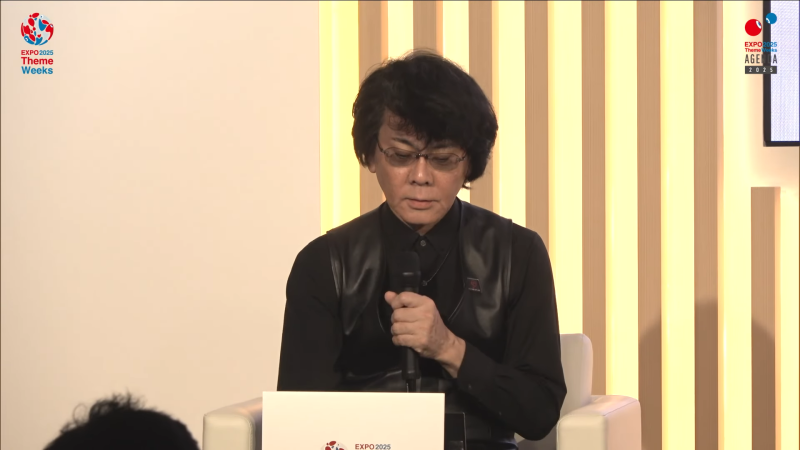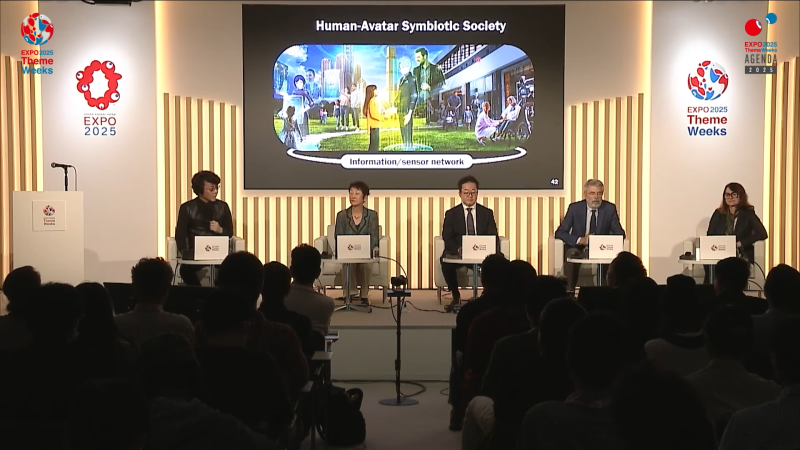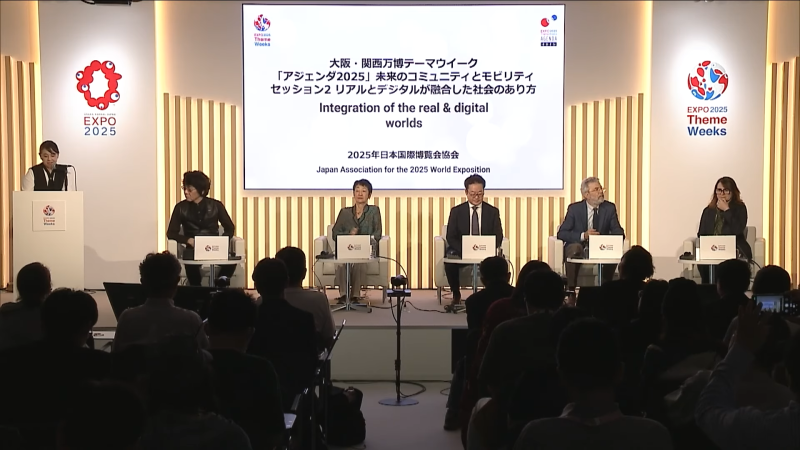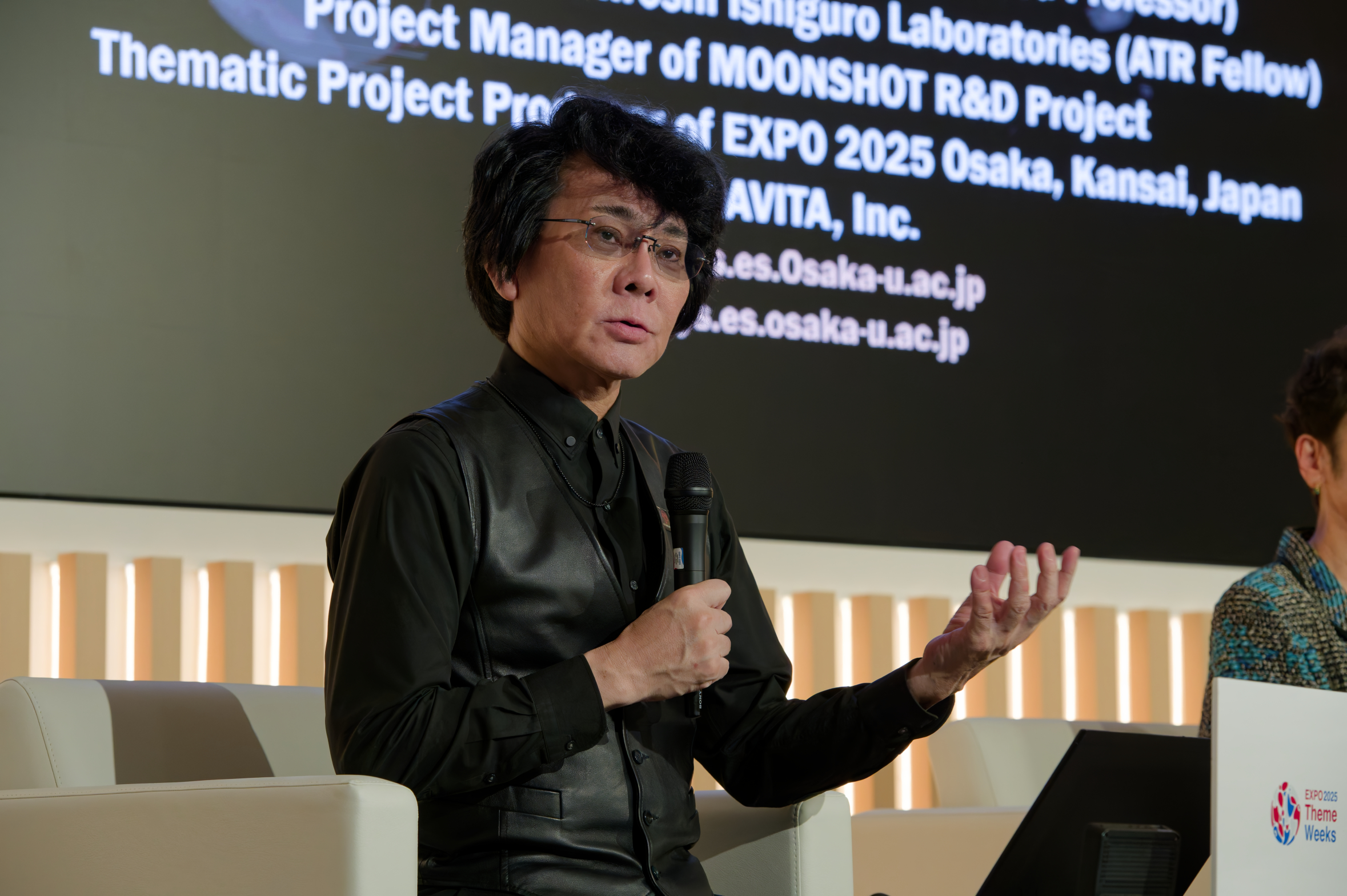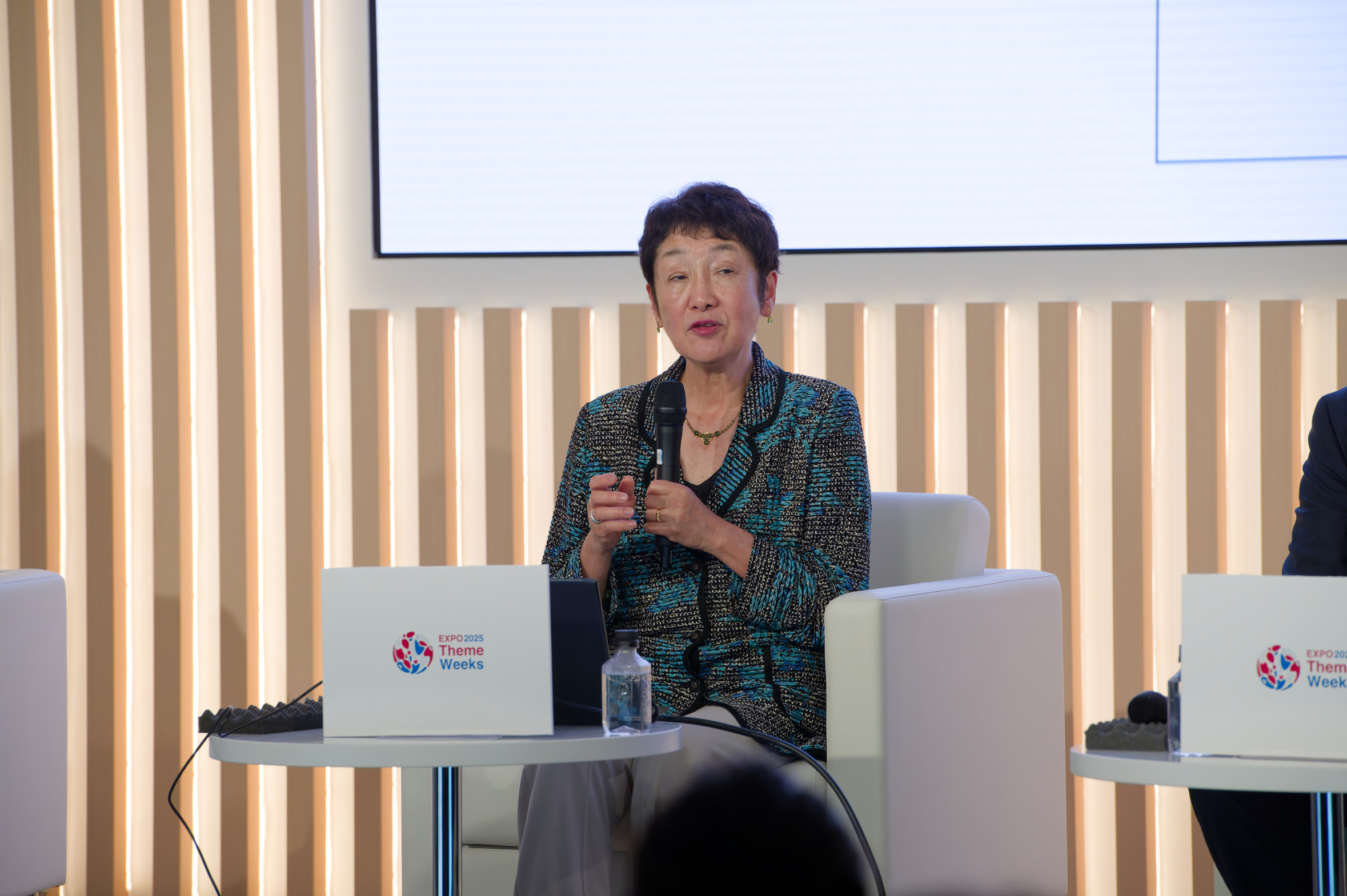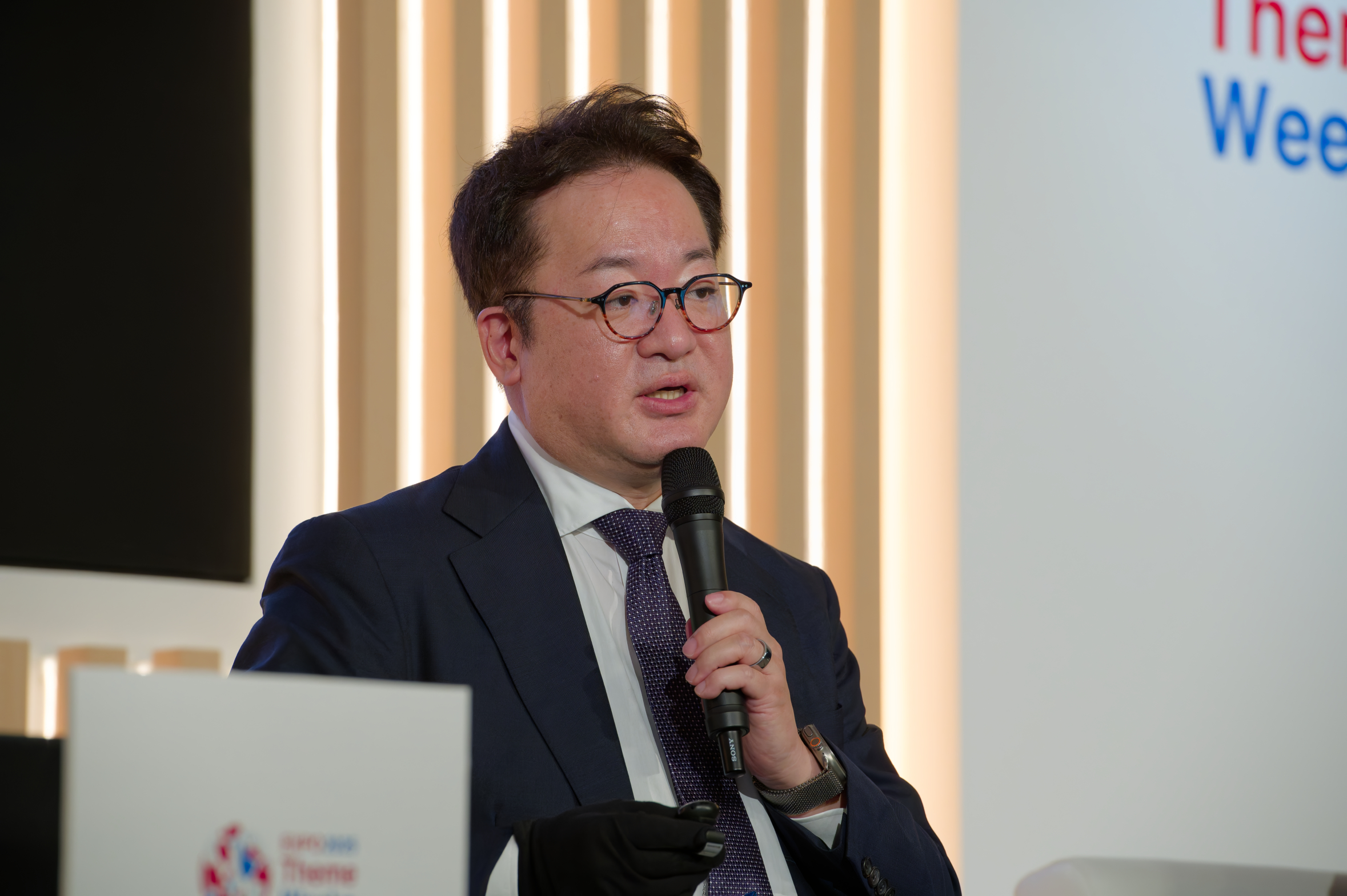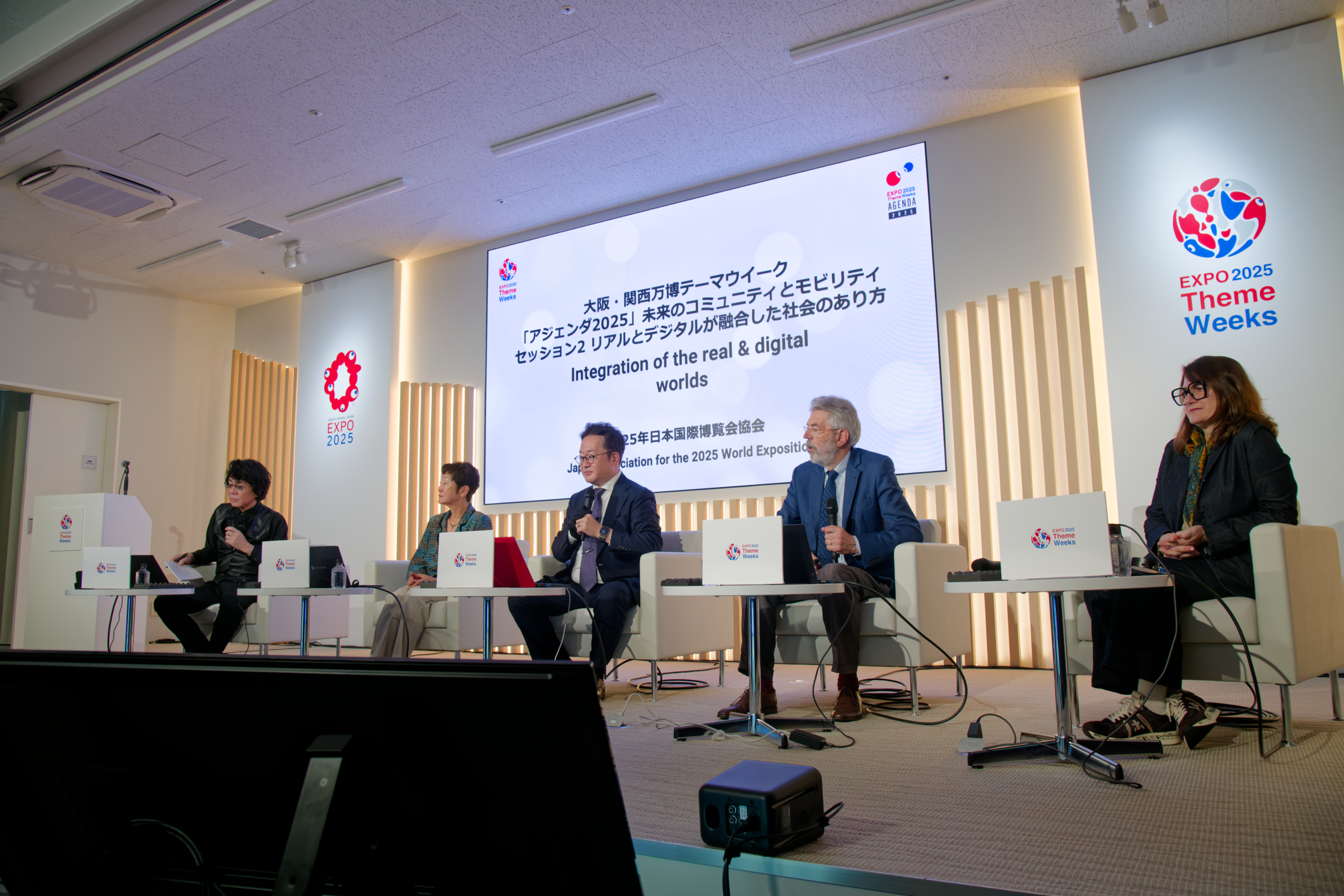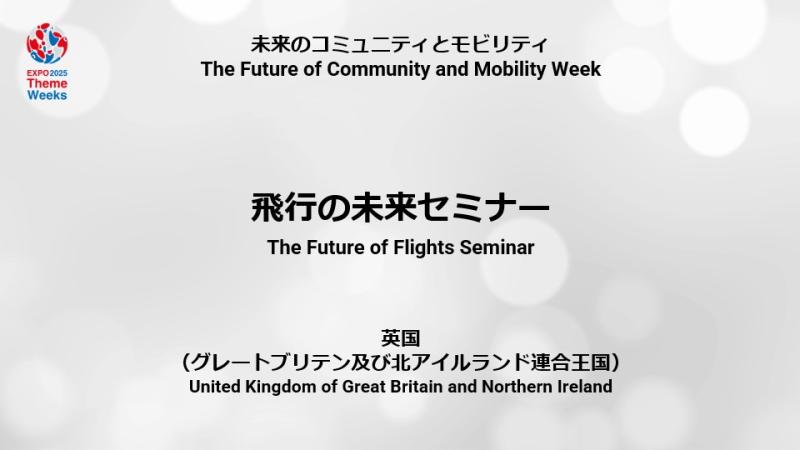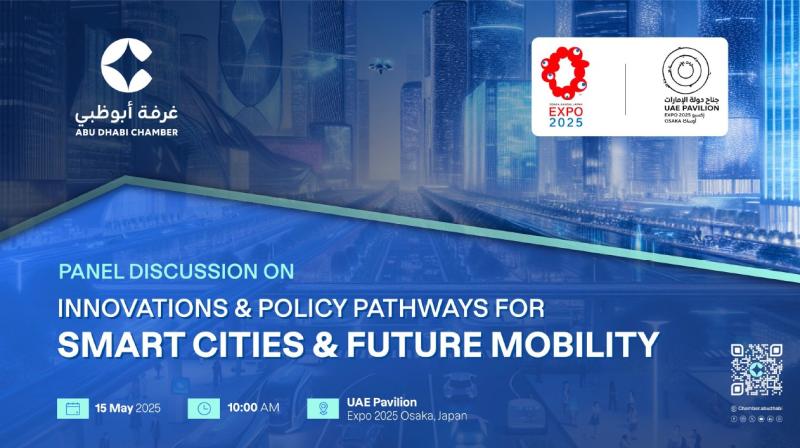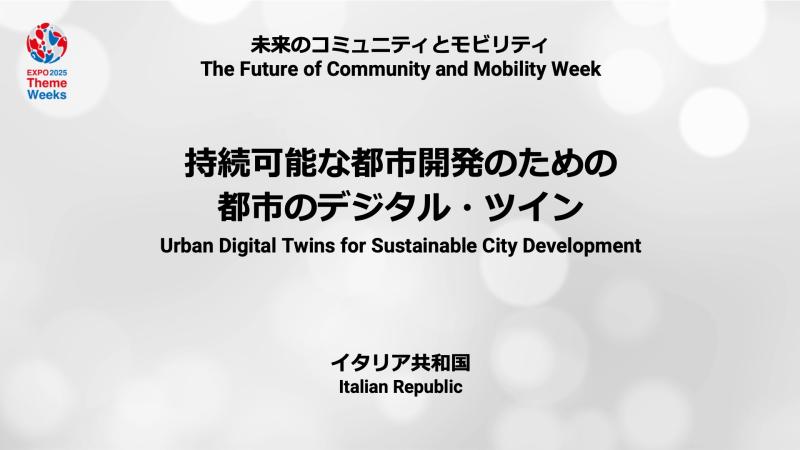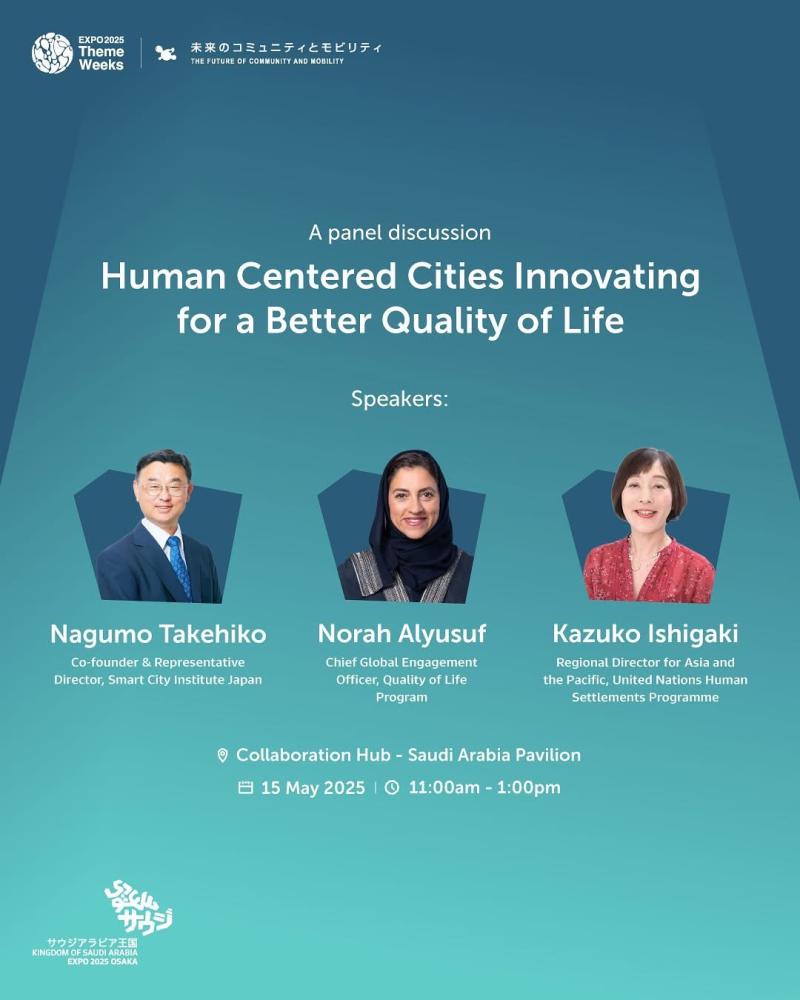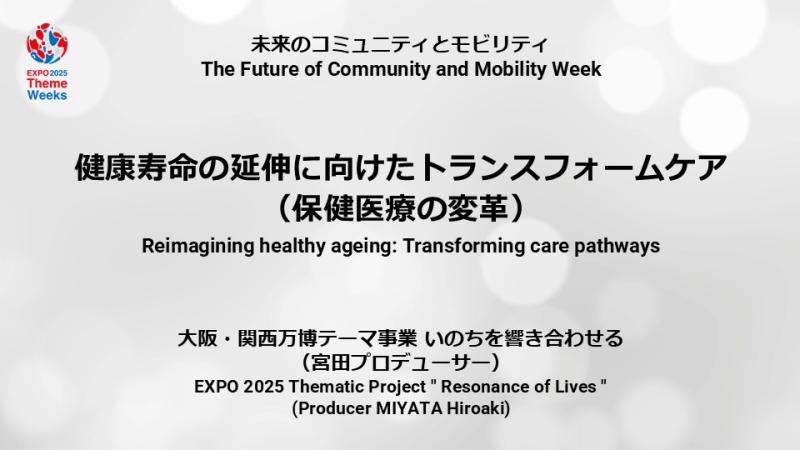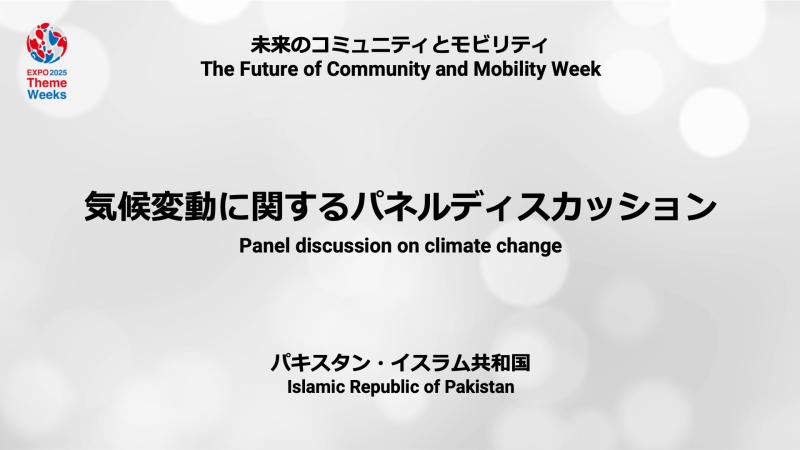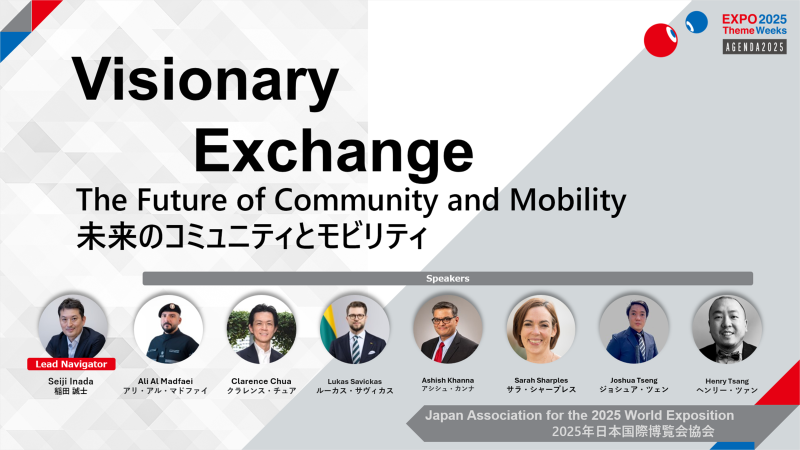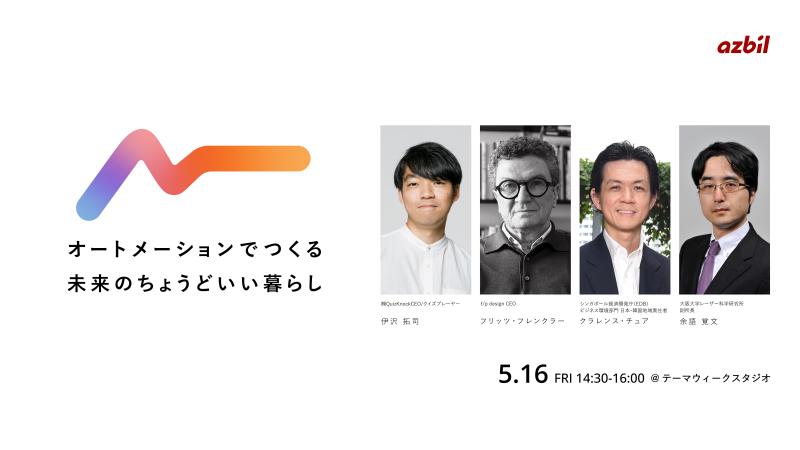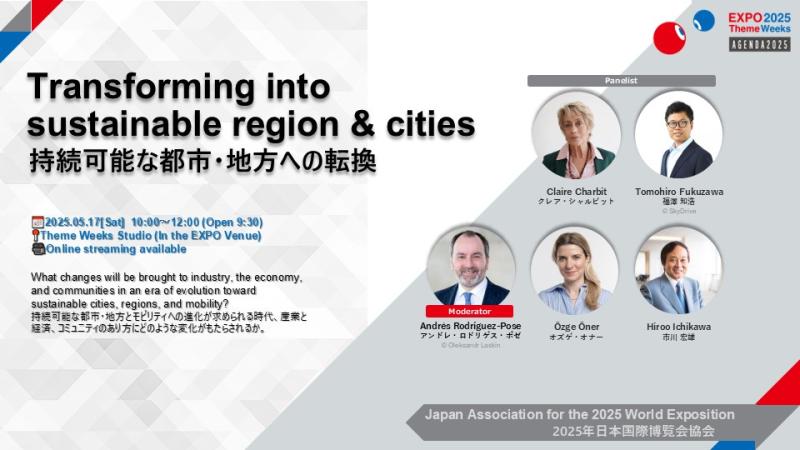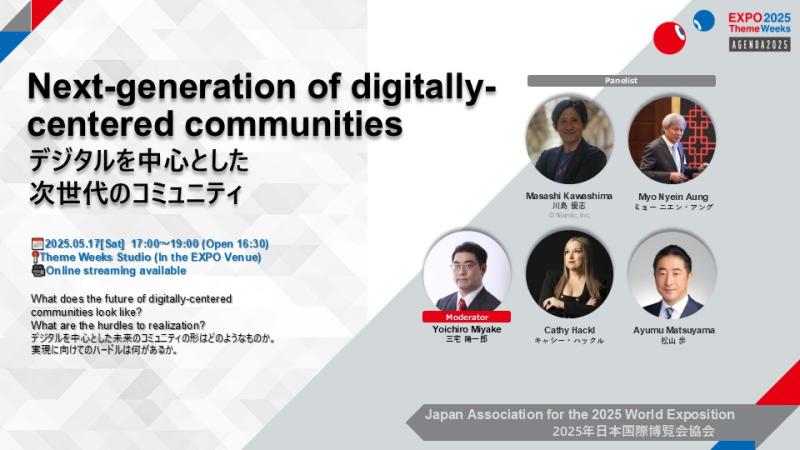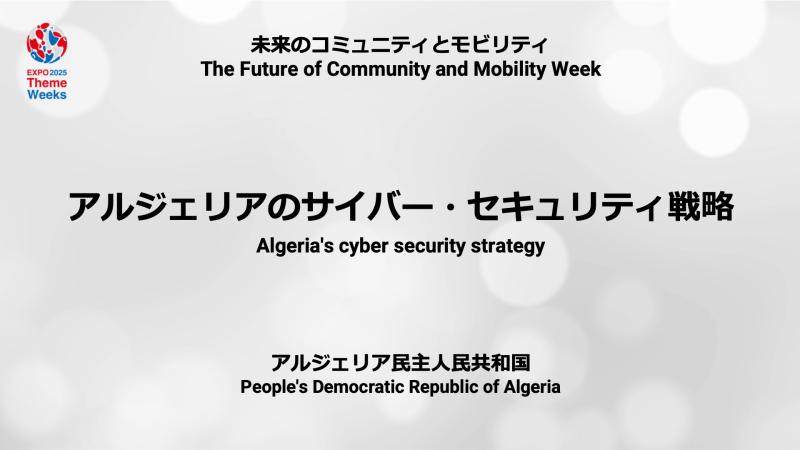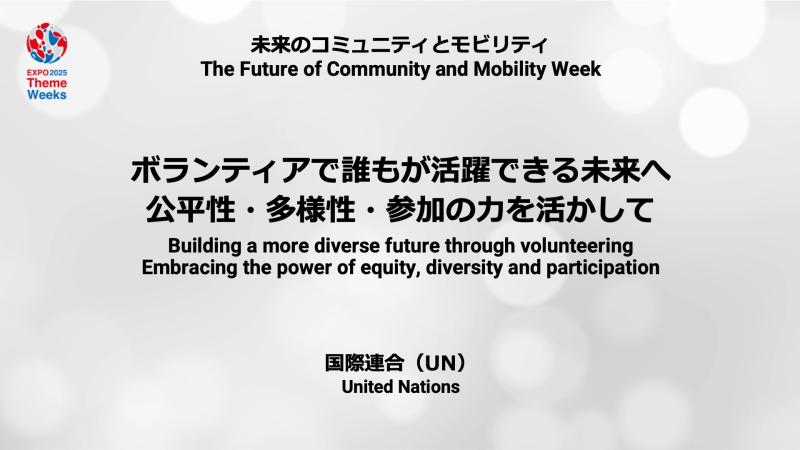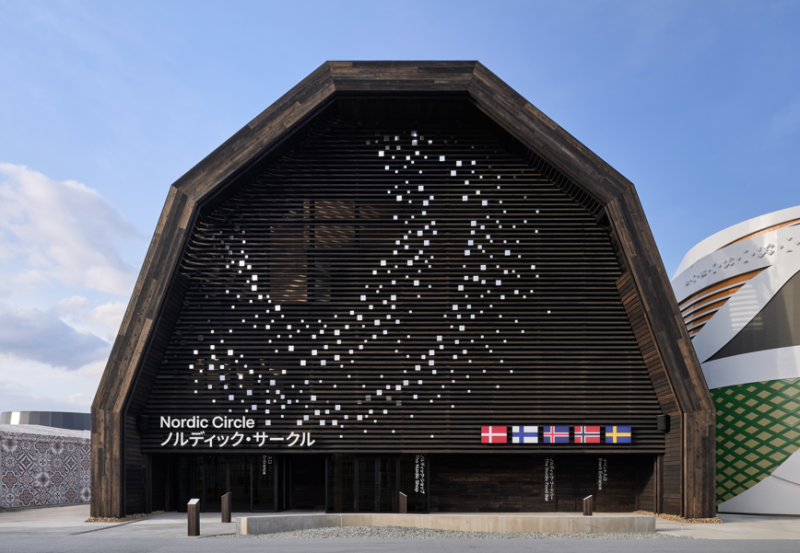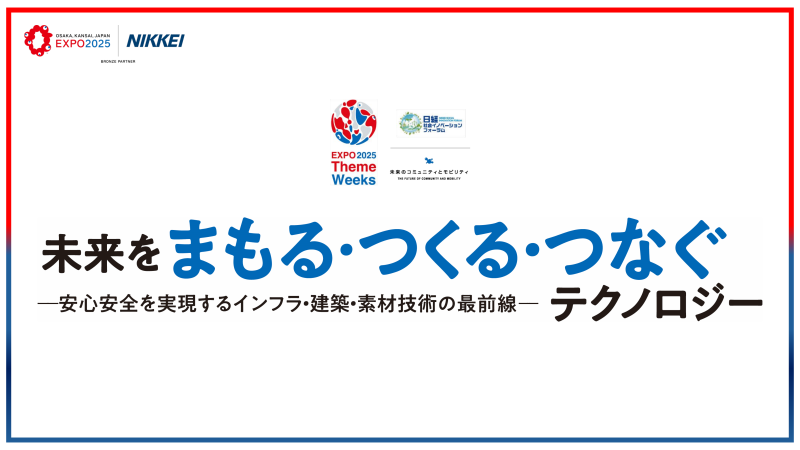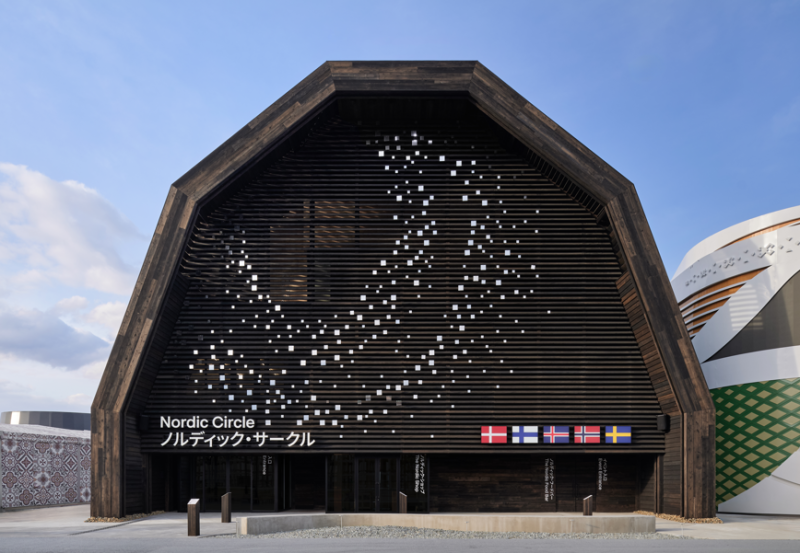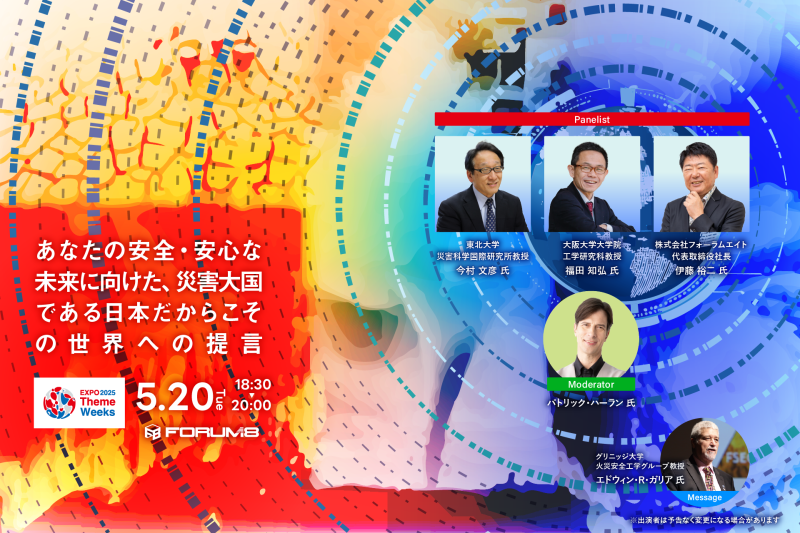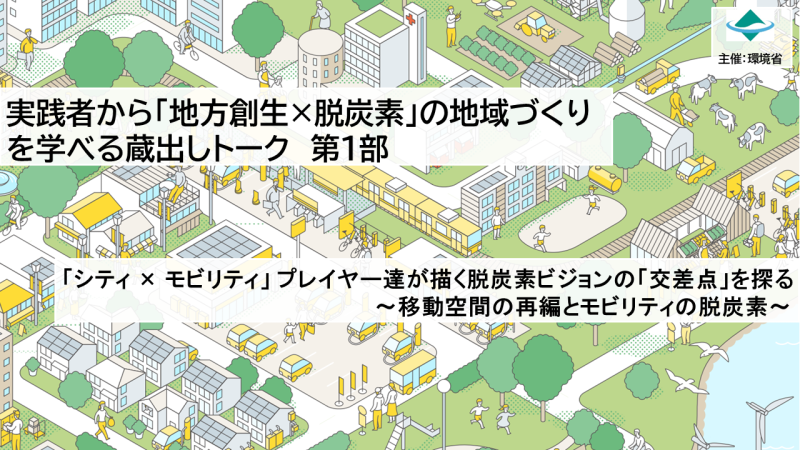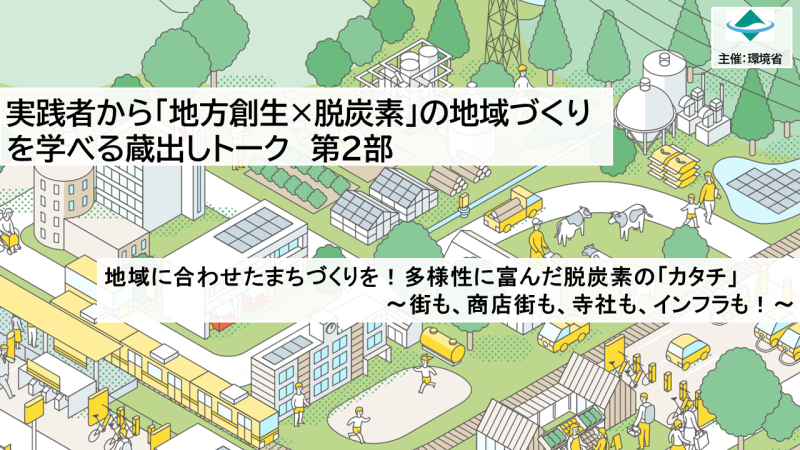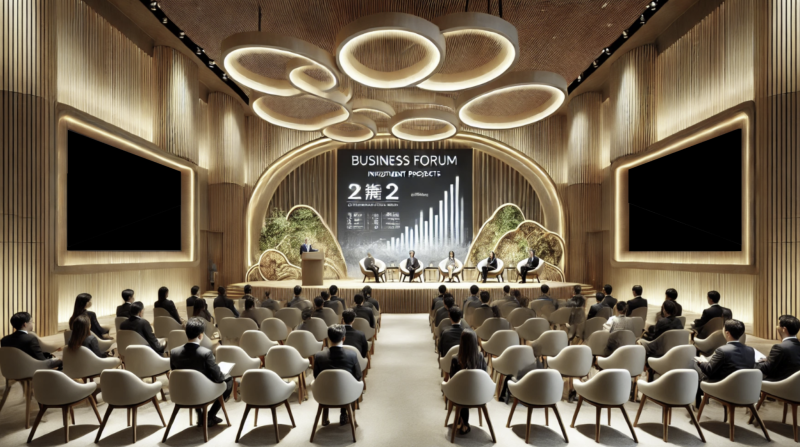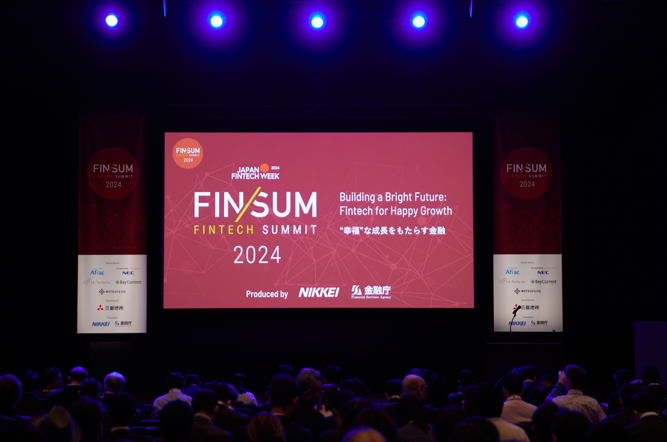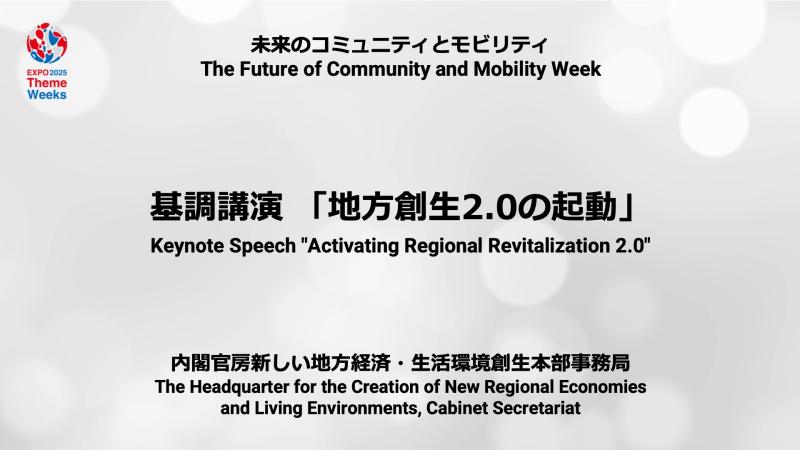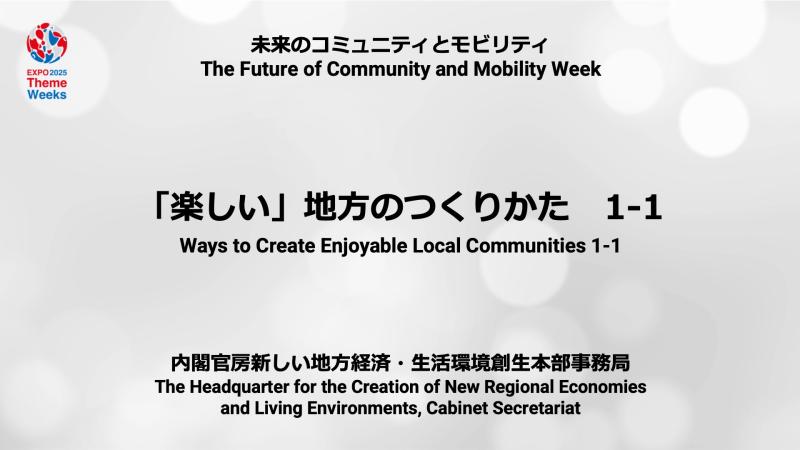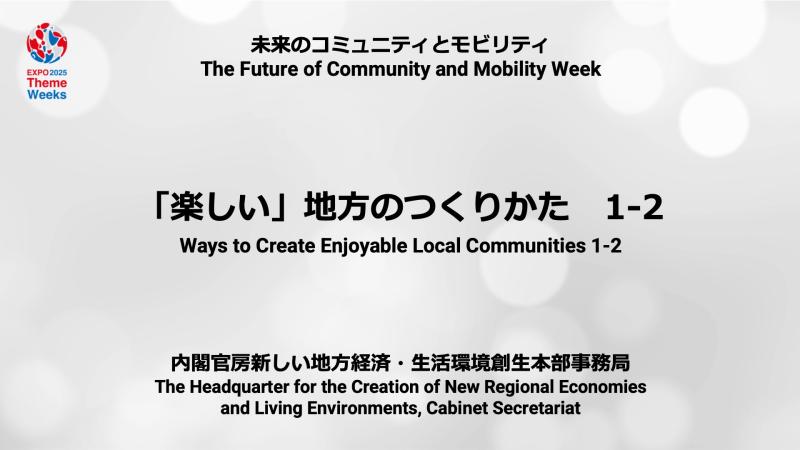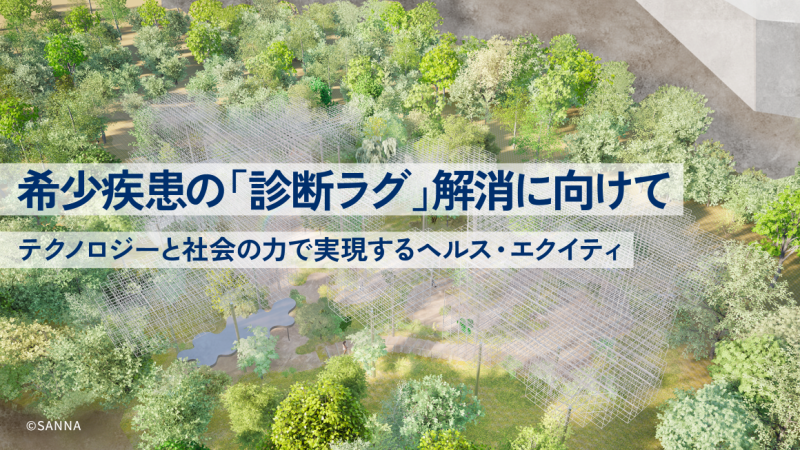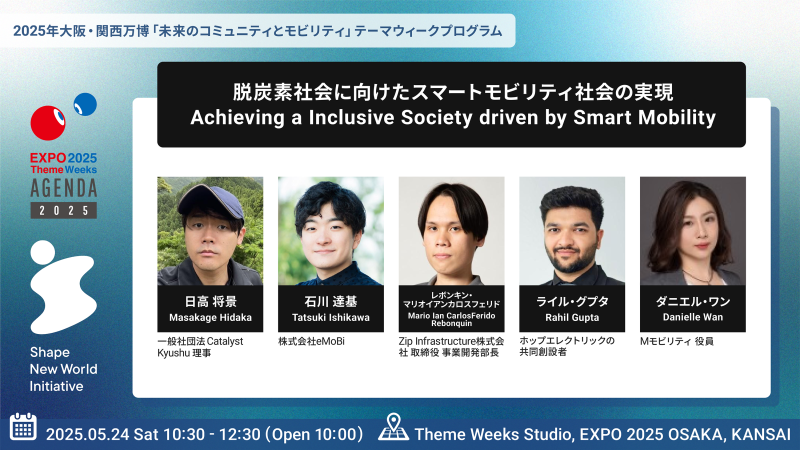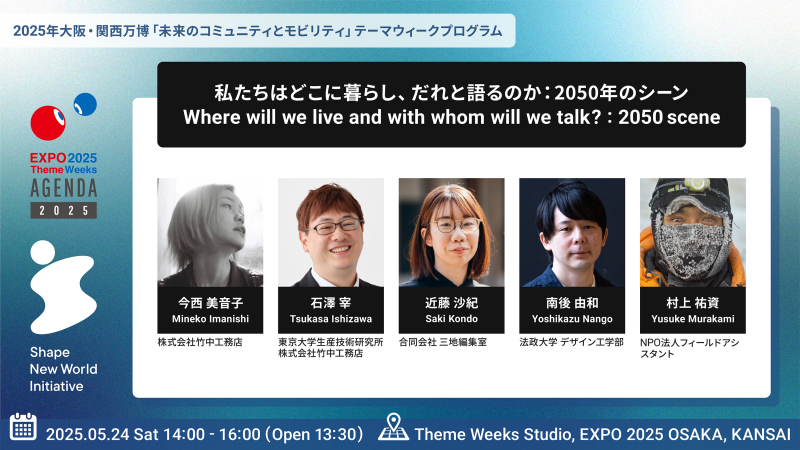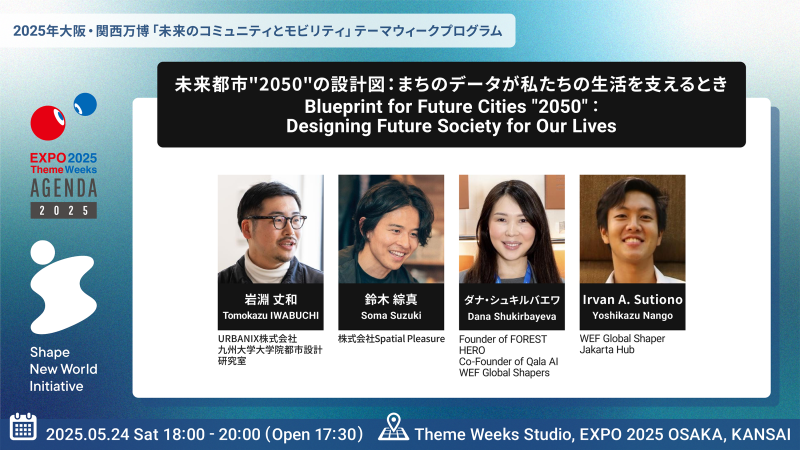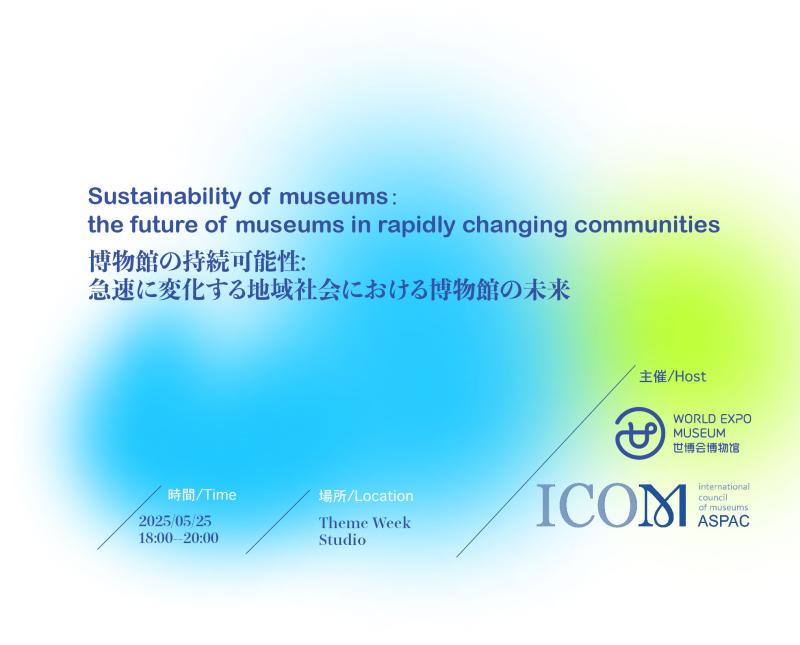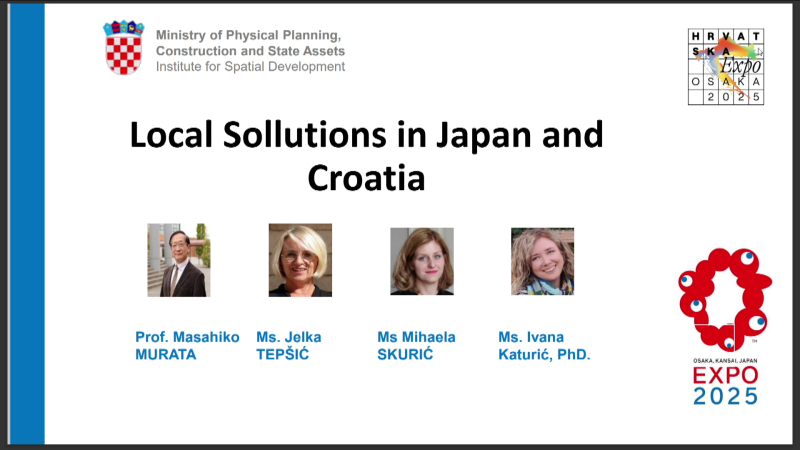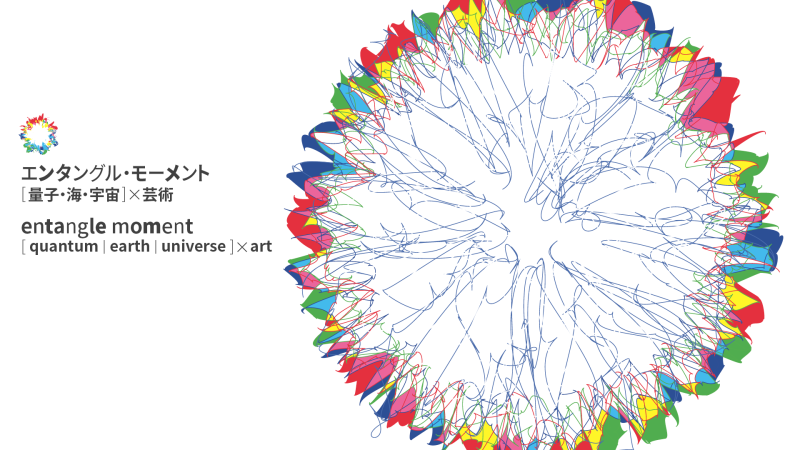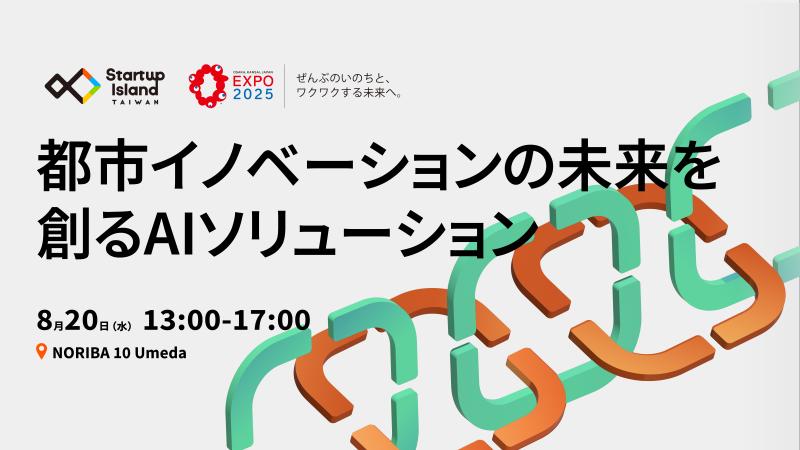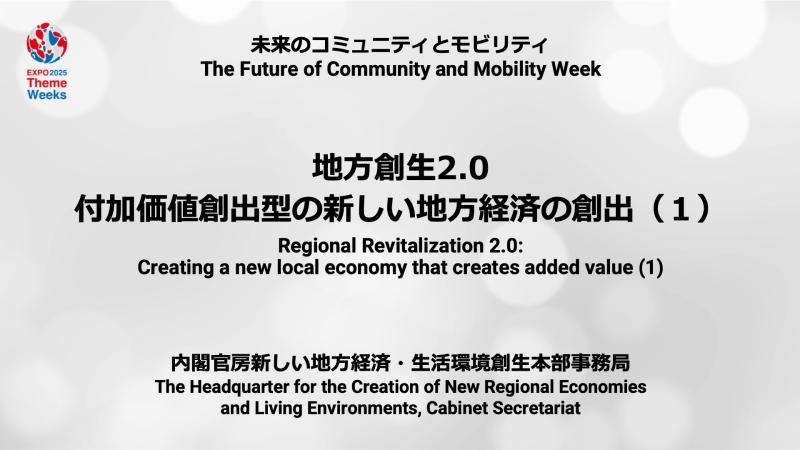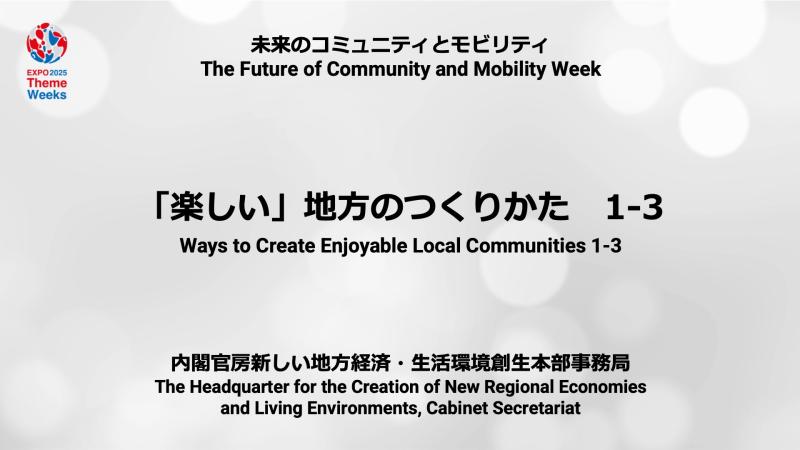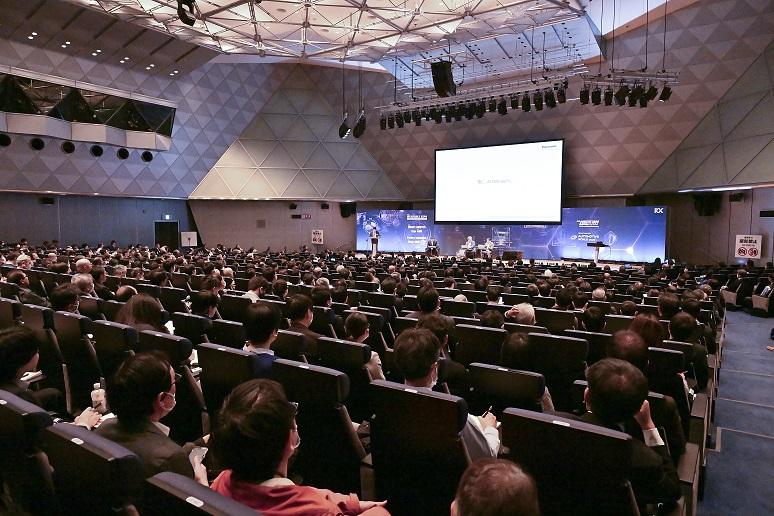The Future of Community and Mobility Week
Integration of the real & digital worlds
Japan Association for the 2025 World Exposition
The programme, together with the General Sponsors, explores: 'How will the integration of real and digital realms affect community & mobility? (Social participation through avatars/humanoids)'
Recorded video available
Discussion
- Others
| Transmission of simultaneous interpretation | Provided |
|---|---|
| Language of interpretation | Japanese and English |
-
Agenda2025
Organised Programme
- Time and
Date of
the event -
-
2025.05.17[Sat]
13:30 ~ 15:30
(Venue Open 13:00)
-
- Venue
- Theme Weeks Studio
Programme details
*Subtitles: Choose “Subtitles/CC” in the “Settings” (gear icon) at the bottom right of the YouTube video. *Subtitles may not show with multiple languages or overlapping audio.
In several countries around the world, not just in Japan, the issues of population decline and labor shortages are becoming increasingly severe. To address these challenges, avatars that enable people to engage freely beyond the constraints of time and space are essential. This discussion will explore how avatars are being accepted globally and how they will shape the future of society.
Reports
【Session Summary】
Held on May 17, 2025, the session “Integration of the real & digital worlds” was part of the “Future of Community and Mobility” theme week at Expo 2025 Osaka-Kansai. This session brought together cutting-edge discussions across avatar technology, physical augmentation, soft robotics, AI, and cognitive science, focusing on how the integration of real and digital spaces is transforming human existence and the structure of society.
Moderator Hiroshi Ishiguro (Osaka University) introduced the potential for overcoming physical, spatial, and temporal limitations through the development and implementation of cybernetic avatars. He also touched upon the notion of "self-continuity" via avatars, suggesting that android technology could one day preserve one’s personality and sensibilities even after death.
The session presented a range of interdisciplinary perspectives that questioned the relationship between technology, society, and human identity. It underscored that avatar technologies are not merely about utility, but serve as a central axis in an ongoing philosophical and cultural transformation.
【Speaker Summary: Hiroshi Ishiguro】
Hiroshi Ishiguro, a pioneering researcher in avatar-based human augmentation, introduced the trajectory of his two-decade research and his vision for future society. Ishiguro advocates for a “cybernetic avatar society” that enables people to act freely beyond the limits of body, brain, space, and time. He envisions new social structures created through semi-autonomous avatars integrated with AI.
His presentation traced the evolution of avatar technologies—from remotely operated avatars to “Geminoid” androids capable of autonomous communication and expression. Notably, he discussed the development of androids that replicate his own memories, personality, and speech patterns—technology aimed at leaving a “copy of oneself” for the future. This touches not only on labor replacement, but also challenges ethical notions surrounding death and social identity.
Ishiguro presented social experiments using avatars, such as interactions between kindergarteners and seniors during the pandemic, remote clerks in convenience stores, and customer service agents in the insurance sector. These examples demonstrated how avatars empower those with limited mobility or social interaction opportunities to participate in society, even contributing to employment and regional revitalization.
He proposed a model of the human as a “multi-bodied being,” where avatars act as extensions of the self. Ishiguro emphasized the importance of “fashion” and “play” in shaping how avatars are socially accepted, suggesting that aesthetic diversity and expressive flexibility will be key to building a broader avatar culture.
He also discussed how Japanese culture, with its openness toward non-human entities, could take international leadership in shaping the avatar-integrated society. Through his reflections, Ishiguro raised a profound question: “What does it mean to be human?” His presentation offered a compelling blueprint for designing the society of tomorrow.
【Speaker Summary: Miwako Doi】
Miwako Doi discussed the transformative potential of avatar technologies through the lens of Moonshot R&D initiatives she is a sub program director. Using a backcasting approach—designing solutions from a future ideal—she presented a vision for 2050, where human society is liberated from the constraints of body, brain, space, and time.
Opening with reflections on her long-standing work in natural language processing, IoT, and wearable technology, Doi traced how these innovations have enriched everyday life. She then introduced the Moonshot Goal 1 initiative, focusing on seven core avatar research projects. Among them is the "symbiotic avatar" promoted by Hiroshi Ishiguro, envisioning a society where humans and avatars coexist.
Doi emphasized the role of avatars in enabling social participation for older adults, persons with disabilities, and those unable to travel. She even proposed a future where avatars could embody the personality and memories of deceased individuals, enabling “posthumous participation” in society—an ethically provocative and imaginative concept.
She also highlighted how avatar labor could enhance well-being and cognitive engagement, fostering inclusion. At the same time, she called for robust policy frameworks, including systems for avatar authentication and international guidelines to ensure trust and reliability.
Concluding her remarks, Doi stressed that cybernetic avatars are not simply tools for labor substitution, but mechanisms for reimagining human presence itself. Her presentation seamlessly bridged future-oriented vision with pragmatic institutional design, pointing toward a future where technology and humanity evolve together.
【Speaker Summary: Masahiko Inami】
Masahiko Inami shared insights from his research on human augmentation, focusing on how technology can reconstruct and expand human physicality and perception. His lab has developed unconventional interfaces such as robotic “superhuman” body parts—including a sixth finger and wing-like appendages—as well as robotic faces capable of reshaping human expressions.
Framing these projects as efforts to “redesign the human body,” Inami argued that the body should not be seen merely as a biological constraint but as a modifiable platform for expression. For instance, technologies like a sixth finger can enhance not only motor skills but also creativity and emotional expression, unlocking new human potentials.
He emphasized the importance of designing interactions where humans remain in control. “Implicit interaction”—technology that supports human intentions without explicit commands—is key. For this, AI capable of understanding sensory and behavioral context becomes essential.
Inami proposed that in a future society enabled by cybernetic avatars, the assumption of “one body, one mind” may no longer hold. People could operate multiple avatars simultaneously or share embodiment and perception with others, raising philosophical and ethical questions about selfhood and accountability.
He also noted how technologies like the metaverse and generative AI allow individuals to construct and customize their environments and bodies. Self-expression in such a world is no longer limited to appearance, but extends to the design of entire experiences. Humans, he suggested, are increasingly becoming “creative agents” rather than mere recipients of the world.
In conclusion, he stressed that avatars and augmentation should not be limited to welfare or labor support. By embracing “play” and “fashion,” these technologies can become embedded in everyday culture. His presentation illuminated a future where technology redefines the human condition, enabling greater freedom and creativity.
【Speaker Summary: Giulio Sandini】
Giulio Sandini, drawing from his extensive work in humanoid robotics and cognitive neuroscience, explored how cybernetic avatars can reshape our understanding of cognition and interaction. Beginning with his early studies on visual perception and eye movement control, Sandini explained how modeling human visual systems laid the foundation for natural human-robot interaction. His subsequent research fused robotics and neuroscience in a bidirectional approach: designing robots based on human understanding and using robots to study human cognition. Through experiments with humanoid robots, he revealed how uniquely human traits like empathy, embodiment, and cognitive development are deeply rooted in social contexts.
Sandini introduced the compelling concept of a “Cognitive Twin,” in which avatars, while evolving from the long term goal of autonomy, build long-term relationships with users, gradually learning their thought patterns, behaviors,and memories. Over time, these avatars could become “cognitive companions” that foster deeper mutual understanding and act more like friends than tools.He stressed the need for interdisciplinary integration in avatar development—not only engineering, but also AI, robotics, cognitive science, ethics, and social sciences. For industry, he emphasized the importance of “human-centered design,” where functionality must be balanced with cultural and social adaptability.
Looking ahead to global deployment, Sandini highlighted the importance of accommodating cultural differences in gestures, language, and expectations. He advocated for international standardization and flexible design to ensure transparency and explainability of avatar behavior, which is essential if avatars are to become a universal cognitive interface. In closing, Sandini stated, “Avatars are not merely imitations of human intelligence—they are mirrors that deepen our understanding of ourselves.” His remarks underscored the societal and philosophical significance of cybernetic avatars, not just as technical achievements but as tools for introspection and empathy.
【Speaker Summary: Cecilia Laschi】
Cecilia Laschi spoke on the future of avatar technologies and embodied intelligence, informed by her research in soft robotics and neuro-robotics. Opening with an overview of her work on biomimetic robots—particularly those inspired by the movements and structures of soft-bodied animals like octopuses—Laschi introduced the concept of “embodied intelligence,” where cognition emerges through physical interaction with the environment.
She emphasized how the structural flexibility of soft bodies simplifies control mechanisms and enhances responsiveness to the environment. This principle, drawn from evolutionary biology, informs the design of avatars and assistive robots that interact seamlessly with humans and surroundings.
Laschi also shared her work in developing assistive technologies for aging societies, such as a soft robotic arm used in Singapore hospitals to gently lift elderly patients. Beyond functionality, she stressed the ethical dimension of robotics—machines should preserve dignity and emotional well-being, not merely deliver physical assistance.
Importantly, she urged a shift in perspective—from “compensating for bodily limitations” to “creating new kinds of bodies.” Avatars, in her view, can surpass prosthetics and become extensions or reimaginings of human capability. Multi-armed avatars or remotely controlled bodies redefine what it means to inhabit a single body.
Laschi envisioned a society where humans, robots, and avatars share responsibilities and build mutual understanding. Rather than being mere proxies, avatars should become collaborative members of communities, active in fields like education, welfare, and urban planning.
In her closing remarks, she stated, “We are not only augmenting bodies—we are at the stage of redesigning society itself.” Her vision reflected a deep integration of scientific insight and ethical awareness, proposing avatars as agents of cultural transformation and inclusive coexistence.
【Discussion Summary】
The session concluded with a panel discussion featuring all speakers, centering on essential questions such as: “How should cybernetic avatars be implemented in society?” and “How will technology impact human identity and social structure?”
Hiroshi Ishiguro reiterated the idea that avatars can help create a society unconstrained by body, brain, space, or time, conceptualizing humans as “multi-bodied beings.” Masahiko Inami emphasized integrating elements of play and fashion into avatar culture to ensure it is embraced by everyday society. He suggested that reaching children and creative industries could facilitate the social acceptance of these technologies.
Miwako Doi highlighted avatars as a means of enabling dignified social participation for individuals facing physical, cognitive, or geographical challenges. She stressed the need for ethical and institutional frameworks—including authentication systems and international standards—to support social implementation.
Giulio Sandini argued that cybernetic avatars must evolve from tools addressing the long-term goal of autonomous partners that achieve mutual understanding and express emotional relationship. He introduced the concept of “Cognitive Twins,”where avatars learn from users to become empathetic companions. Realizing this visionrequires interdisciplinary collaboration grounded in a deep understanding of human cognition.
Cecilia Laschi emphasized the embodied and societal dimensions of avatars, calling for their design not as secondary actors but as collaborative members of society. In fields like healthcare and caregiving, ethical flexibility and design inclusivity are critical to ensuring harmonious human-robot coexistence.
A shared theme emerged: the real and digital are not opposites, but complementary. Technologies like the metaverse, AR, and multi-location avatars are dissolving the boundaries between physical and virtual realities. This evolution prompts a fundamental redefinition of the self.
In closing, Ishiguro remarked, “We are not changing society through technology—we are rebuilding society by questioning what it means to be human.” The discussion reaffirmed that avatars are not just technological products, but social and philosophical entities embedded in evolving human values.
Cast
Moderator
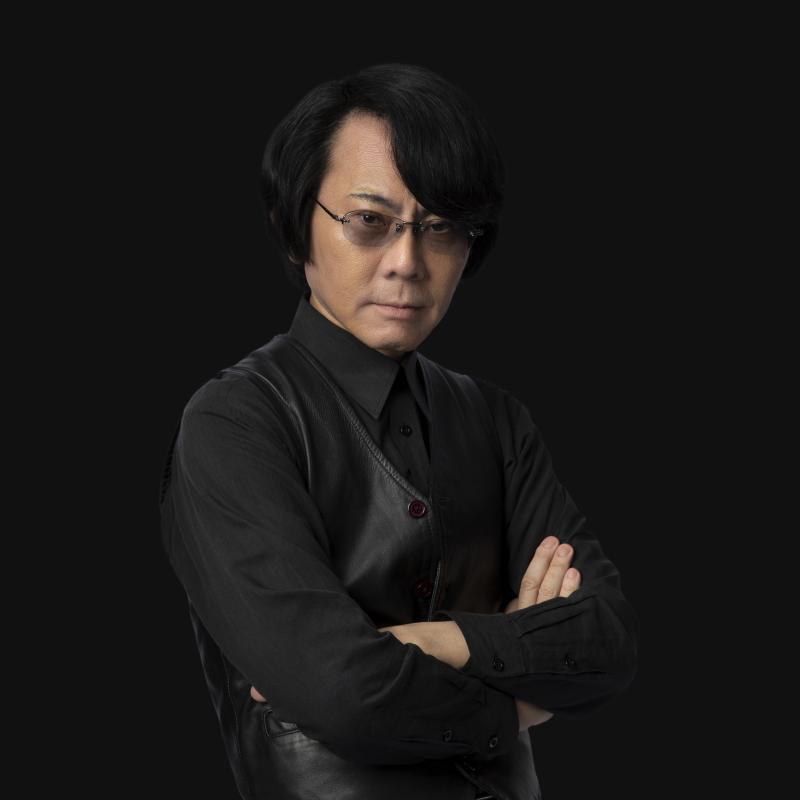
Hiroshi Ishiguro
Professor of Department of Systems Innovation, Osaka University, Visiting Director of ATR Hiroshi Ishiguro Laboratories
Visiting Director of ATR Hiroshi Ishiguro Laboratories His research interests are interactive robotics, avatar, and android science. Geminoid is an avatar android that is a copy of himself. In 2011, he won the Osaka Cultural Award. In 2015, he received the Prize for Science and Technology by the Minister of Education, Culture, Sports, Science and Technology. He was also awarded the Sheikh Mohammed Bin Rashid Al Maktoum Knowledge Award in Dubai in 2015. Tateisi Award in 2020.
View Profile
Close
close
Speakers

Masahiko Inami, Ph.D
Special Advisor to the President for The University of Tokyo, Deputy Director / Professor for Advanced Science and Technology
Masahiko Inami, Ph.D.
Special Advisor to the President for The University of Tokyo, Deputy Director / Professor for Advanced Science and Technology
Dr. Masahiko Inami took up his current position as professor at the University of Tokyo after working at the University of Electro-Communications and Keio University.
His interests include “JIZAI body editing technology,” the Augmented Human, and entertainment engineering.
He has received several awards, including TIME Magazine’s “Coolest Invention of the Year” award and the Young Scientist Award and Research Category Award from the Ministry of Education, Culture, Sports, Science, and Technology (MEXT).
He is also a director of the Information Processing Society of Japan, a director of the Virtual Reality Society of Japan, and a member of the Science Council of Japan.
His latest book is called “Theory of JIZAI Body" (Springer, 2023).
View Profile
Close
close

Giulio Sandini
Istituto Italiano di Tecnologia Robotics, Brain and Cognitive Sciences Unit
Giulio Sandini is Founding Director of the Italian Institute of Technology where in 2006 established the department of Robotics, Brain and Cognitive Sciences. As Assistant Professor at the Scuola Normale in Pisa and Visiting Researcher at the Neurology Department of the Harvard Medical School he investigated visual perception, sensorimotor coordination in humans and technologies for Brain Activity Mapping to study children with learning disabilities. In 1996 he was Visiting Scientist at the Artificial Intelligence Lab of MIT.
As a professor of bioengineering at the University of Genova in 1990 he founded the LIRA-Lab (Laboratory for Integrated Advanced Robotics) which, with a focus on developmental robotcs, was to become the birthplace of a family of humanoid robots including the “open source” iCub platform which, designed within the EU-funded collaborative project RobotCub, has later become a reference humanoid platform of the Italian Institute of Technology.
Giulio Sandini research activity is characterized by an engineering approach to the study of natural intelligent systems with a focus on the design and implementation of embodied artificial systems to investigate the development of human perceptual, motor and cognitive abilities.
View Profile
Close
close
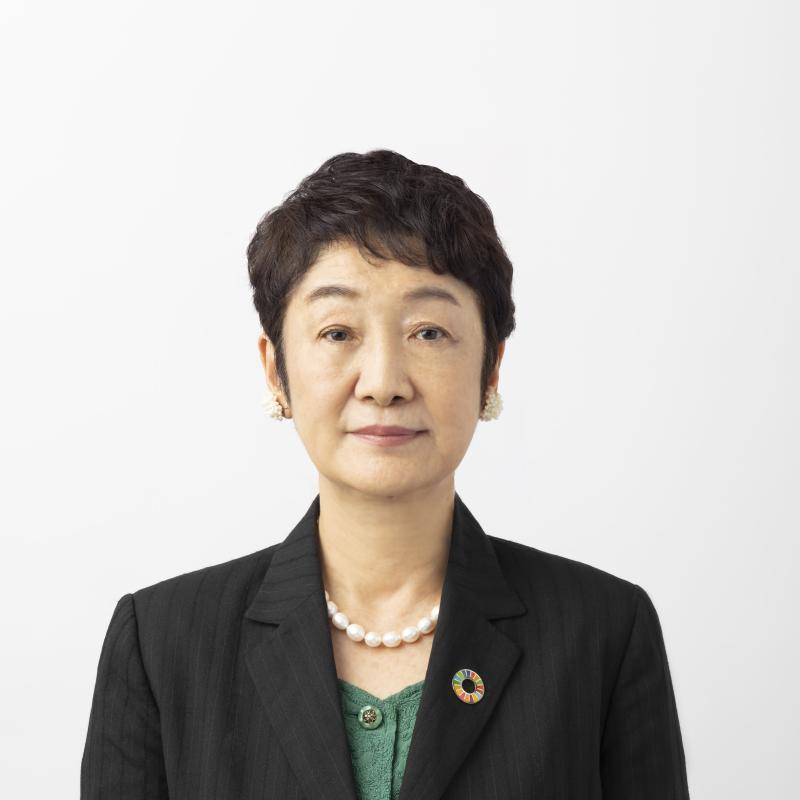
Miwako Doi
Auditor, Nationatil Institute of Information and Communications Technology, Vice President for Data Strategy and Co-Creation, Tohoku University Executive Director, NARA Institute of Science and Technology
She received her B.E. and M.E. and Ph.D. degrees in 1977, 1979 and 2002 from the Univ. of Tokyo. She joined Toshiba in 1979 and has been a researcher of human interface technology and involved in developing a portable Japanese word processor, a machine translation system, a CG chip for video games, a pedestrian navigation system for mobile phones, and so on over 35 years.
She is an invited professor of Osaka University, Guest Professor of Tokyo University of Agriculture and Technology, Guest Professor of Osaka University of Arts, Sub Project Director of Moonshot Goal1 and others.
She got 28prizes: the Grand Prize of Tateishi Prize, the Commendation for Science and Technology by the Minister of Education, Culture, Sports, Science and Technology, Award of the Minister of Internal Affairs and Communications, the Achievement Award, the Society Activity Contribution Award, the Best Author award from the Information Processing Society of Japan, a prize of National Commendation for Invention, and so on. She authored and co-authored 13 books, over 300 patents, over 300 technical papers on multimedia information system, human interface design, and so on.
She had been members of Ministry of Land, Infrastructure, Transport and Tourism - Transport Safety Commission, Ministry of Internal Affairs and Communications - Independent Administrative Agency Accuracy Evaluation Committee, Information and Communications Council Committee, Ministry of Education, Culture, Sports, Science and Technology - University Establishment and Corporation Committee, Science and Technology Policy Council Committee, and so on.
View Profile
Close
close

Cecilia Laschi
Provost's Chair Professor, National University of Singapore
Cecilia Laschi is Provost’s Chair Professor at the National University of Singapore, Director of Advanced Robotics Centre (ARC) and Co-Director of CARTIN – Centre for Advanced Robotics Technology and Innovation. She is on leave from Scuola Superiore Sant'Anna, Italy, The BioRobotics Institute. She graduated in Computer Science at University of Pisa and received a Ph.D. in Robotics from University of Genoa. She received an Honorary Doctorate from the University of Southern Denmark, Odense.
Cecilia Laschi is best-known for her research in soft robotics, an area that she pioneered and contributed to develop at international level. She uses a bioinspired approach starting from the octopus as a model for robotics. She explores marine applications of soft robots and their use in the biomedical field, specifically in eldercare.
She is Editor-in-Chief of Bioinspiration & Biomimetics and Specialty Chief Editor of Soft Robotics in Frontiers in Robotics & AI. She is Editorial Board member of Science Robotics, IEEE Robotics & Automation Letters, International Journal of Robotics Research, and the Intelligent Robotics and Autonomous Agents (IRAA) Series of MIT Press. She serves as evaluators for the EC (incl. ERC programme), HFSP and national research agencies.
She is IEEE Fellow and member of AAAS, I-RIM (Italian Institute of Intelligent Machines) and GNB (Italian National Group of Bioengineering). She is member of the IEEE Robotics & Automation Society (RAS), where she was elected twice as AdCom member and co-founded the Technical Committee (TC) on Soft Robotics. She founded and chaired the 1st IEEE-RAS International Conference on Soft Robotics (RoboSoft) in 2018, serving now in its Steering Committee. She was Co-Chair of Gordon Research Conference on Robotics 2024 and Program Chair of the IEEE/RSJ International Conference on Intelligent Systems – IROS in 2018 and in 2024. She co-founded the spin-off company RoboTech, in edutainment robotics.
View Profile
Close
close
The Future of Community and Mobility Week
Integration of the real & digital worlds
The programme, together with the General Sponsors, explores: 'How will the integration of real and digital realms affect community & mobility? (Social participation through avatars/humanoids)'
-
2025.05.17[Sat]
13:30~15:30
(Venue Open 13:00)
- Theme Weeks Studio
- * Programme times and content are subject to change. Any changes will be announced on this website and via the ticket booking system.
- * The schedule is subject to change depending on the organiser's circumstances.
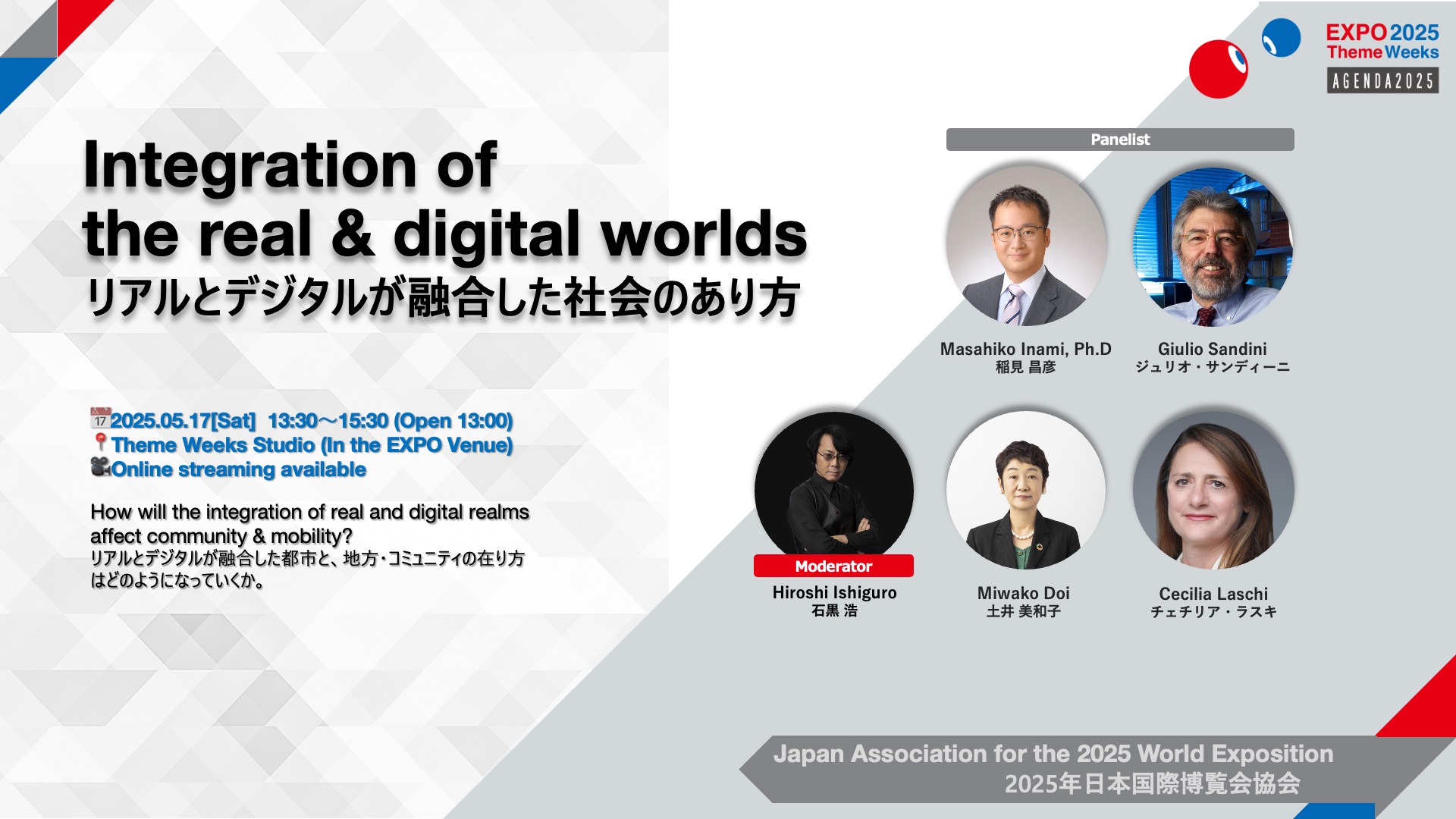
OTHER PROGRAM
The Future of Community and Mobility Week


